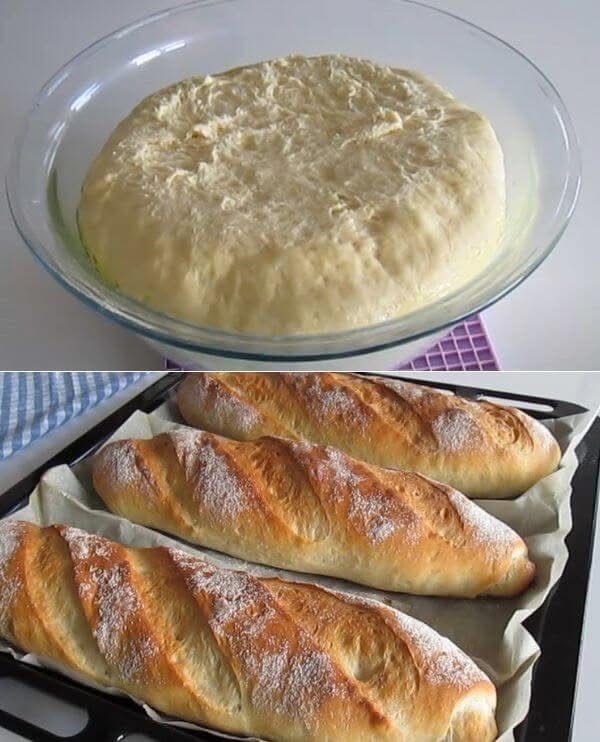Homemade French Bread Recipe Soft Crusty Irresistible

Introduction
There’s nothing quite like the aroma of freshly baked bread filling your kitchen. Homemade French bread, with its golden crust and soft, airy inside, is a staple in many households worldwide. Whether you’re making it for a cozy breakfast, a sandwich, or just to enjoy with butter, this bread is a true delight.
This recipe will take you through the journey of making homemade French bread from scratch. You’ll learn about its history, the benefits of making your own bread, and the techniques to achieve that perfect balance of a crispy crust and soft interior.
History of French Bread
French bread has been a beloved staple for centuries, dating back to the 17th century when long, slender loaves became popular. The traditional baguette as we know it today was officially recognized in the early 20th century, gaining its iconic shape due to new laws that restricted bakers from working at night. These laws led to the creation of a bread that could be made quickly in the morning and sold fresh.
Homemade French bread has evolved, but the principles remain the same: a simple combination of flour, yeast, water, and salt, crafted into a beautiful, crusty loaf.
Ingredients
- 4 cups (500g) bread flour (or all-purpose flour)
- 1 ½ cups (350ml) warm water
- 2 ¼ teaspoons (1 packet) active dry yeast
- 2 teaspoons salt
- 1 tablespoon sugar
- 1 tablespoon olive oil (optional, for extra softness)
- 1 tablespoon cornmeal (for dusting the baking sheet)
- 1 egg white + 1 tablespoon water (for brushing, optional)
Instructions
Step 1: Activate the Yeast
- In a small bowl, combine warm water (not hot, about 110°F or 43°C) and sugar. Stir until dissolved.
- Sprinkle the yeast over the water and let it sit for about 5–10 minutes until it becomes foamy. This means the yeast is activated.
Step 2: Prepare the Dough
- In a large mixing bowl, combine the flour and salt.
- Make a well in the center and pour in the activated yeast mixture.
- Mix with a wooden spoon or a stand mixer fitted with a dough hook until a shaggy dough forms.
- Knead the dough on a floured surface for about 8–10 minutes until smooth and elastic. If using a mixer, knead for about 5 minutes on medium speed.
Step 3: First Rise
- Lightly oil a large bowl and place the dough inside. Cover with a damp cloth or plastic wrap.
- Let the dough rise in a warm place for about 1 to 1.5 hours until it doubles in size.
Step 4: Shaping the Loaves
- Once the dough has risen, punch it down to remove air bubbles.
- Divide the dough into two equal parts.
- Roll each piece into a long loaf shape, about 12–14 inches in length.
- Place the loaves on a baking sheet lined with parchment paper and lightly dusted with cornmeal.
Step 5: Second Rise
- Cover the loaves loosely with a towel and let them rise again for 30–45 minutes.
- Preheat the oven to 425°F (220°C) while the dough is rising.
Step 6: Scoring and Baking
- Use a sharp knife or razor blade to make 3–4 diagonal slashes on each loaf. This helps the bread expand while baking.
- If desired, brush the tops with an egg white wash for a glossy finish.
- Bake in the preheated oven for 20–25 minutes, or until golden brown.
Step 7: Cooling
- Remove from the oven and let the loaves cool on a wire rack for at least 15 minutes before slicing.
Benefits of Homemade French Bread
- Healthier Ingredients: No preservatives or additives, just pure, fresh ingredients.
- Better Flavor: Freshly baked bread tastes better than store-bought versions.
- Cost-Effective: Making your own bread is much cheaper than buying artisan loaves.
- Control Over Ingredients: Adjust salt, sugar, and flour types to suit your dietary needs.
- Aromatherapy: The smell of baking bread is scientifically proven to boost happiness!
Methods for Perfect French Bread
- Steam for a Crispy Crust: Place a pan of hot water in the oven while baking. This creates steam, giving the bread that classic crispy crust.
- Use Bread Flour: While all-purpose flour works, bread flour gives a chewier texture.
- Knead Properly: Kneading develops gluten, giving the bread structure and elasticity.
- Allow Proper Rising Time: Be patient; the dough needs time to develop its texture.
- Bake on a Pizza Stone or Cast-Iron Sheet: This helps create a better crust.
Nutritional Information (Per Slice, Approximate)
- Calories: 120
- Carbohydrates: 24g
- Protein: 4g
- Fat: 0.5g
- Fiber: 1g
- Sodium: 200mg
How to Enjoy French Bread
French bread is incredibly versatile! Here are some ideas:
- Classic with Butter: A warm slice with butter is heavenly.
- Garlic Bread: Slice, spread with garlic butter, and toast.
- Sandwiches: Perfect for subs, paninis, or bruschetta.
- Dipping: Serve with olive oil, balsamic vinegar, or soups.
- French Toast: Stale French bread makes the best French toast!
Conclusion
Making homemade French bread is a rewarding experience that fills your home with warmth and deliciousness. With a crispy crust and a soft, airy interior, this bread is perfect for any occasion. Once you master this recipe, you’ll never want store-bought bread again!
Whether you’re a seasoned baker or a beginner, this simple yet classic recipe will bring joy to your kitchen. So roll up your sleeves, knead that dough, and enjoy the magic of fresh, homemade bread!
Who Will Love This Recipe?
- Bread lovers – If you adore freshly baked bread, this is for you.
- Home cooks – Perfect for anyone who enjoys making food from scratch.
- Baking enthusiasts – Great for beginners and experienced bakers alike.
- Health-conscious eaters – No preservatives or artificial additives.